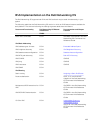of double colons is supported in a single address. Any number of consecutive 0000 groups may be
reduced to two colons, as long as there is only one double colon used in an address. Leading and/or
trailing zeros in a group can also be omitted (as in ::1 for localhost, 1:: for network addresses and :: for
unspecified addresses).
All the addresses in the following list are all valid and equivalent.
• 2001:0db8:0000:0000:0000:0000:1428:57ab
• 2001:0db8:0000:0000:0000::1428:57ab
• 2001:0db8:0:0:0:0:1428:57ab
• 2001:0db8:0:0::1428:57ab
• 2001:0db8::1428:57ab
• 2001:db8::1428:57ab
IPv6 networks are written using classless inter-domain routing (CIDR) notation. An IPv6 network (or
subnet) is a contiguous group of IPv6 addresses the size of which must be a power of two; the initial bits
of addresses, which are identical for all hosts in the network, are called the network's prefix.
A network is denoted by the first address in the network and the size in bits of the prefix (in decimal),
separated with a slash. Because a single host is seen as a network with a 128-bit prefix, host addresses
may be written with a following /128.
For example, 2001:0db8:1234::/48 stands for the network with addresses
2001:0db8:1234:0000:0000:0000:0000:0000 through 2001:0db8:1234:ffff:ffff:ffff:ffff:ffff.
Link-local Addresses
Link-local addresses, starting with fe80:, are assigned only in the local link area.
The addresses are generated usually automatically by the operating system's IP layer for each network
interface. This provides instant automatic network connectivity for any IPv6 host and means that if several
hosts connect to a common hub or switch, they have an instant communication path via their link-local
IPv6 address.
Link-local addresses cannot be routed to the public Internet.
Static and Dynamic Addressing
Static IPv6 addresses are manually assigned to a computer by an administrator.
Dynamic IPv6 addresses are assigned either randomly or by a server using dynamic host configuration
protocol (DHCP). Even though IPv6 addresses assigned using DHCP may stay the same for long periods
of time, they can change. In some cases, a network administrator may implement dynamically assigned
static IPv6 addresses. In this case, a DHCP server is used, but it is specifically configured to always assign
the same IPv6 address to a particular computer, and never to assign that IP address to another computer.
This allows static IPv6 addresses to be configured in one place, without having to specifically configure
each computer on the network in a different way.
In IPv6, every interface, whether using static or dynamic address assignments, also receives a local-link
address automatically in the fe80::/64 subnet.
464
IPv6 Routing


















